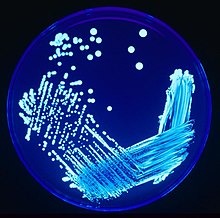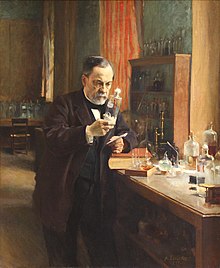Bacteriology

Bacteriology is the branch and specialty of
Overview

Definition
Bacteriology is the study of bacteria and their relation to medicine. Bacteriology evolved from physicians needing to apply the
Bacteriologists
A bacteriologist is a microbiologist or other trained professional in bacteriology. Bacteriologists are interested in studying and learning about bacteria, as well as using their skills in clinical settings. This includes investigating properties of bacteria such as morphology, ecology, genetics and biochemistry, phylogenetics, genomics and many other areas related to bacteria like disease diagnostic testing.[8] They can also work as medical scientists, veterinary scientists, or diagnostic technicians in locations like clinics, blood banks, hospitals, laboratories and animal hospitals.[9][10] Bacteriologists working in public health or biomedical research help develop vaccines for public use.[11]
Culturing bacteria

The growth of bacteria in laboratory cultures is the mainstay method used by bacteriologists. Both solid and liquid culture media are used. Solid culture medium is usually nutrient agar in a petri dish. The constituents of the nutrient agar vary according to the bacteria under investigation. For growing the bacterium Haemophilus influenzae, for example, which is dependent on hemin and nicotinamide adenine dinucleotide for its growth, blood (usually from a sheep or a horse) is added to the medium.[12] When growing bacteria that are found in the intestines of mammals, such as salmonella, XLD agar which contains, among other ingredients deoxycholic acid is used.[13]
History



Bacteria were first observed by the Dutch microscopist
In the 1840s, Semmelweis' observations and ideas surrounding sanitary techniques were rejected and his book on the topic condemned by the medical community due to its conflict with the prevailing theory and practice of humorism at the time.[17] After Lister's publications, which supported hand washing and sanitation with germ theory, doctors started sanitizing their hands in the 1870s; mandatory handwashing was not incorporated into common health practice until as late as the 1980s.[18]
The discovery of the connection of microorganisms to disease came later in the nineteenth century, when German physician Robert Koch introduced the science of microorganisms including bacteria to the medical field.[19] Koch, a pioneer in medical microbiology, worked on cholera, anthrax and tuberculosis. In his research into tuberculosis Koch finally proved the germ theory, for which he received a Nobel Prize in 1905.[5] In Koch's postulates, he set out criteria to test if an organism is the cause of a disease, and these postulates are still used today.[20][6] Both Koch and Pasteur played a role in improving antisepsis in medical treatment. In 1870-1885 the modern methods of bacteriology technique were introduced by the use of stains, and by the method of separating mixtures of organisms on plates of nutrient media.[6][7]
Though it had been known since the nineteenth century that bacteria are a cause of many diseases, no effective antibacterial treatments were available until the 20th century.[21] In 1910, Paul Ehrlich developed the first antibiotic, by changing dyes that selectively stained Treponema pallidum—the spirochaete that causes syphilis—into compounds that selectively killed the pathogen.[22] Ehrlich was awarded a 1908 Nobel Prize for his work on immunology, and pioneered the use of stains to detect and identify bacteria, with his work being the basis of the Gram stain and the Ziehl–Neelsen stain.[23]
A major step forward in the study of bacteria came in 1977 when
References
- ^ Wassenaar, T. M. "Bacteriology: the study of bacteria". www.mmgc.eu. Archived from the original on 24 July 2011. Retrieved 18 June 2011.
- ^ MacNeal, Ward J.; Williams, Herbert Upham (1914). Pathogenic micro-organisms; a text-book of microbiology for physicians and students of medicine. P. Blakiston's Sons. pp. 1–. Retrieved 18 June 2011.
- ISBN 978-0-306-42346-8. Retrieved 18 June 2011.
- ^ Dahal, Prashant (2022-08-28). "Streak Plate Method - Principle, Types, Methods, Uses". Microbe Notes.
- ^ a b "The Nobel Prize in Physiology or Medicine 1905". Nobelprize.org. Archived from the original on 10 December 2006. Retrieved 22 November 2006.
- ^ ISBN 9780470015902.
- ^ PMID 21413299. NBK8120.
- ^ "Bacteriologist: Job Description, Duties and Salary". Study.com. Retrieved 2017-04-03.
- ^ "Bacteriologist: Job Description, Duties and Salary". Best Accredited Colleges. 2021-10-20.
- ^ "About | American College of Veterinary Microbiologists". www.acvm.us. Retrieved 2022-12-14.
- ^ "Vaccines Working Group". National Institutes of Health (NIH). 2020-09-03. Retrieved 2022-12-14.
- S2CID 42022492.
- S2CID 249877386.
- ^ Chung KT. "Ferdinand Julius Cohn (1828–1898): Pioneer of Bacteriology" (PDF). Department of Microbiology and Molecular Cell Sciences, The University of Memphis. Archived (PDF) from the original on 27 July 2011.
- ^ Drews, Gerhart (1999). "Ferdinand Cohn, a founder of modern microbiology" (PDF). ASM News. 65 (8): 547–52. Archived from the original (PDF) on 13 July 2017.
- ^ "Pasteur's Papers on the Germ Theory". LSU Law Center's Medical and Public Health Law Site, Historic Public Health Articles. Archived from the original on 18 December 2006. Retrieved 23 November 2006.
- OCLC 56198835.
- ^ 'Wash your hands' was once controversial medical advice, National Geographic.
- PMID 24516751.
- PMID 8902385.
- PMID 11167573.
- PMID 15014180.
- ^ "Biography of Paul Ehrlich". Nobelprize.org. Archived from the original on 28 November 2006. Retrieved 26 November 2006.
- PMID 270744.
- OCLC 85814089.
